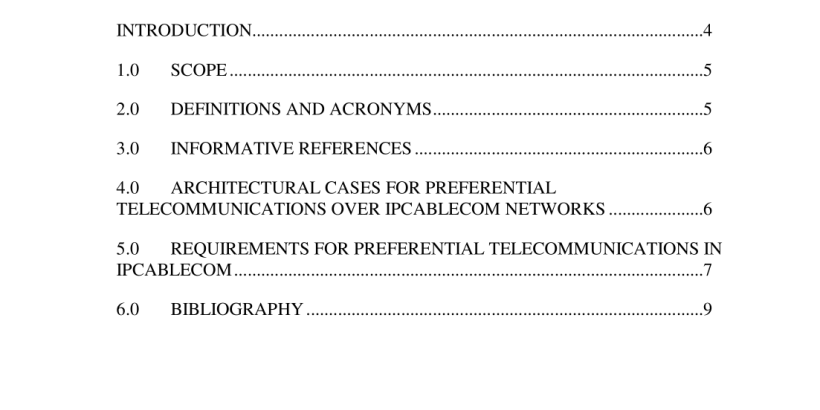ANSI SCTE 173-1-2017 pdf download.Requirements for Preferential Telecommunications over IPCablecom Networks
Emergency/disaster communications for authorized users plays a vital role in the health, safety, and welfare of people in all countries. The common thread to facilitate emergency/disaster operations is the utility of assured capabilities for user-friendly emergency telecommunications that may be realized by technical solutions and/or administrative policy. The IPCablecom infrastructure offers an important resource for assured emergency/disaster communications. Emergency/disaster situations can impact communications infrastructures. Typical impacts may include congestion overload and the need to re-deploy or extend communications capabilities beyond that covered by existing infrastructures. Even when telecommunications infrastructures are not damaged by these situations, demand for telecommunications resources soar during such events. Therefore, priority mechanisms are needed so that limited bandwidth resources can be allocated to authorized emergency workers. Generally, when preferential or priority treatment telecommunication capabilities are offered, users of the service will be authenticated and authorized. Whether authentication and authorization are required or not is a national decision. However, without authentication and authorization, preferential treatment capabilities may be subject to abuse by non-authorized individuals. This standard defines requirements for authentication and priority mechanisms in IPCablecom networks to provide preferential/priority treatment to services that need or benefit from such treatment.
1.0 SCOPE
The objective of this standard is to provide an initial set of requirements for preferential telecommunications within IPCablecom networks. Aspects of preferential telecommunications include provisions for Authentication and Priority (Special Handling). These requirements do not apply to ordinary emergency calls such as people calling police, fire department, ambulance, etc. This standard defines requirements for capabilities which when implemented should help support emergency telecommunication services. Note: Pre-emption requirements and authorization requirements are outside the scope of this standard and are considered to be national matters.
5.0 REQUIREMENTS FOR PREFERENTIAL TELECOMMUNICATIONS IN IPCABLECOM
The following requirements are for authentication and prioritization capabilities within IPCablecom networks. This initial set of requirements can be implemented utilizing existing mechanisms or extensions to existing mechanisms found within IPCablecom and elsewhere. Future enhancements as well as internetworking details will await the work of other ITU-T Study Groups. The requirements focus on call control but some of them might also apply to voice traffic as well. Whether mechanisms need to be developed for the voice traffic as well as the call control depend upon the methods used for the priority and authentication. Ideally, all methods of priority treatment will be applied to a priority call. However, it is recognized that satisfying a subset of the below listed Requirements will improve the access for preferential users and that a phased approach to implementation is desirable.
5.1 Requirements for Authentication in IPCablecom Networks Users with priority, generally, will be authenticated 1 and authorized. Whether authentication for preferential users is required or not is a national matter. In the case where authentication is not required it is assumed that preferential users are authorized by default. Ideally, at least two authentication mechanisms will be supported in IPCablecom networks. Some services may require only one method, however.
5.1.1 One method of authentication of calls originating in an IPCablecom network will be available to a preferential user on any given IPCablecom user’s equipment. One way this can be accomplished is by calling a special number and entering a personal identification number (PIN).
5.1.2 One method of authentication will be dependent upon the IPCablecom system’s recognition of the preferential users’ equipment. This authentication will only be available on particular pieces of equipment (e.g. phones, CM/MTAs) and may additionally require further mechanisms (e.g. smartcards, tokens, and/or a PIN). Smartcards specifications are outside the scope of IPCablecom.ANSI SCTE 173-1-2017 pdf download
